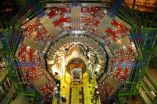(Press-News.org) This press release is available in German.
How many matter particles exist in nature? Particle physicists have been dealing with this question for a long time. The 12 matter particles contained in the standard model of particle physics? Or are there further particles with too high a mass to be produced by the experiments performed so far? These questions are now answered by researchers of KIT, CERN, and Humboldt University in the current issue of the Physical Review Letters. (DOI: 10.1103/PhysRevLett.109.241802)
Matter particles, also called fermions, are the elementary components of the universe. They make up everything we see on earth or through telescopes. "For a long time, however, it was not clear whether we know all components," explains Ulrich Nierste, Professor at KIT. The standard model of particle physics knows 12 fermions. Based on their similar properties, they are divided into three generations of four particles each. Only the first generation of particles occurs in appreciable amount outside of particle accelerators. Among these particles are the electron, the electron neutrino, and the up-quark and down-quark. Up- and down-quarks form heavier particles, such as protons and neutrons and, hence, all elements of the periodic system.
"But why does nature have second and third generations, if these are hardly needed? And are there maybe more generations of particles?", ask the main authors of the article, Martin Wiebusch and Otto Eberhardt. At least, the latter question is answered: "There are exactly three fermion generations in the standard model of particle physics!"
For their analysis, the researchers combined latest data collected by the particle accelerators LHC and Tevatron with many known measurements results relating to particles, such as the Z-boson or the top-quark. The result of the statistical analysis is that the existence of further fermions can be excluded with a probability of 99.99999 percent (5.3 sigma). The most important data used for this analysis come from the recently discovered Higgs particle.
The Higgs particle gives all other particles their mass. As additional fermions were not detected directly in accelerator experiments, they have to be heavier than the fermions known so far. Hence, these fermions would also interact with the Higgs particle more strongly. This interaction would have modified the properties of the Higgs particle such that this particle would not have been detected. With the exclusion of the fourth fermion generation the first open question of particle physics is now answered by the measurements made at the new LHC particle accelerator ring of CERN.
"Within the standard model the number of fermions is now firmly established," explains Nierste. However, some interesting questions remain. The properties of the just discovered Higgs particle still have to be determined and it has to be found out why there is more matter than antimatter in the universe.
INFORMATION:
Karlsruhe Institute of Technology (KIT) is a public corporation according to the legislation of the state of Baden-Württemberg. It fulfills the mission of a university and the mission of a national research center of the Helmholtz Association. KIT focuses on a knowledge triangle that links the tasks of research, teaching, and innovation.
This press release is available on the internet at www.kit.edu.
The photo of printing quality may be downloaded under www.kit.edu or requested by mail to presse@kit.edu or phone 49-721-608-47414. The photo may be used in the context given above exclusively.
12 matter particles suffice in nature
Limited number of matter particles in the standard model of particle physics / no fourth fermion generation / statistical analysis of Higgs data
2012-12-13
ELSE PRESS RELEASES FROM THIS DATE:
Study sheds light on how cells transport materials along crowded intercellular 'highways'
2012-12-13
Worcester, Mass. – The interior of an animal cell is like a small city, with factories—called organelles—dedicated to manufacturing, energy production, waste processing, and other life functions. A network of intercellular "highways," called microtubules, enables bio-molecular complexes, products, and other cargo to move speedily about the cell to keep this vital machinery humming. A new paper published online in the journal Proceedings of the National Academy of Sciences sheds new light on how cells manage to keep traffic flowing smoothly along this busy transportation ...
Your Christmas tree and its genome have remained very much the same over the last 100 million years
2012-12-13
This press release is available in French.
Quebec City, December 13, 2012—A study published by Université Laval researchers and their colleagues from the Canadian Forest Service reveals that the genome of conifers such as spruce, pine, and fir has remained very much the same for over 100 million years. This remarkable genomic stability explains the resemblance between today's conifers and fossils dating back to the days when dinosaurs roamed the Earth. Details of this finding are presented in a recent issue of the journal BMC Biology.
The team supervised by Professor ...
OU study suggests the bacterial ecology that lives on humans has changed in the last 100 years
2012-12-13
A University of Oklahoma-led study has demonstrated that ancient DNA can be used to understand ancient human microbiomes. The microbiomes from ancient people have broad reaching implications for understanding recent changes to human health, such as what good bacteria might have been lost as a result of our current abundant use of antibiotics and aseptic practices.
Cecil M. Lewis Jr., professor of anthropology in the OU College of Arts and Sciences and director of the OU Molecular Anthropology Laboratory, and Raul Tito, OU Research Associate, led the research study that ...
Hospital-based neurologists worry about career burnout
2012-12-13
MAYWOOD, Il. - A survey has identified career burnout as a significant problem among neurologists who predominantly work with hospital inpatients.
Nearly 29 percent of these "neurohospitalists" said they had experienced burnout, and 45.8 percent said they were concerned about burnout but had not yet experienced it. (Burnout was defined as maintaining a schedule so burdensome as to limit the time a physician will or could spend as a neurohospitalist.)
Results were published in the December, 2012 issue of Neurology® Clinical Practice. Among the co-authors is Jose Biller, ...
Predicting risk of arrhythmias and sudden cardiac death: There's a computer model for that
2012-12-13
VIDEO:
Scientists are using "virtual hearts " to better understand risk in real-world patients. Researcher Coeli Lopes, Ph.D., University of Rochester Medical Center, assistant professor at the Aab Cardiovascular Research Institute, describes...
Click here for more information.
A computer model of the heart wall predicted risk of irregular heart rhythms and sudden cardiac death in patients, paving the way for the use of more complex cardiac models to calculate the ...
New policy brief examines impact of occupational injuries and illnesses among low-wage workers
2012-12-13
WASHINGTON, D.C.—Low-wage workers, who make up a large and growing share of the U.S. workforce, are especially vulnerable to financial hits that can result from on-the-job injuries and illnesses, according to a policy brief released today by researchers at the George Washington University School of Public Health and Health Services (SPHHS). The policy brief, "Mom's off Work 'Cause She Got Hurt: The Economic Impact of Workplace Injuries and Illnesses in the U.S.'s Growing Low-Wage Workforce," was released along with a white paper showing that such workplace injuries and ...
Time restrictions on TV advertisements ineffective in reducing youth exposure to alcohol ads
2012-12-13
Efforts to reduce underage exposure to alcohol advertising by implementing time restrictions have not worked, according to new research from the Center on Alcohol Marketing and Youth (CAMY) at the Johns Hopkins Bloomberg School of Public Health and the Dutch Institute for Alcohol Policy. The report, published in the Journal of Public Affairs, confirms what Dutch researchers had already learned in that country: time restrictions on alcohol advertising actually increase teen exposure, because companies move the advertising to late night.
In 2009, Dutch regulators sought ...
'Curiosity' can be positioned with eclipses
2012-12-13
Observations from 'Curiosity' when Mar's moon Phobos crosses in front of the sun, like in September, help us to understand exactly where the rover is on the red planet. Researchers at the Complutense University of Madrid (Spain) have developed a method for achieving precisely this.
The exact location of Curiosity on the surface of Mars is determined using data transmitted from its antennas as well as the space probes that orbit the red planet. It is very unlikely that these systems would fail but in such an eventuality there would be an alternative for determining the ...
Uncovering a flaw in drug testing for chronic anxiety disorder
2012-12-13
Pre-clinical trials — the stage at which medications or therapies are tested on animals like laboratory mice — is a crucial part of drug development. It's only then that scientists can assess benefits and side effects before a drug is administered to patients.
Now, Prof. Ilan Golani of Tel Aviv University's Department of Zoology and Sagol School for Neuroscience and his fellow researchers Prof. Yoav Benjamini of TAU's Department of Statistics and Operations Research and the Sagol School of Neuroscience, and Dr. Ehud Fonio of the Weizmann Institute are questioning the ...
UAlberta medical researchers discover new potential chemotherapy
2012-12-13
Medical researchers at the University of Alberta have discovered that knocking out a particular "partner" gene is the Achilles' heel of some cancers.
Cancer causing genes often have a partner in crime, meaning when either of the two genes is active in cancer cells, the tumour grows. The challenge for researchers has been pinpointing the genes’ “lethal partners.” Loss of one of the partners alone isn’t deadly to the cell, but if both are gotten rid of, the cancer cells are destroyed.
Faculty of Medicine & Dentistry researcher Michael Weinfeld and his collaborators, ...
LAST 30 PRESS RELEASES:
This new understanding of T cell receptors may improve cancer immunotherapies
A new fossil face sheds light on early migrations of ancient human ancestor
A new immunotherapy approach could work for many types of cancer
A new way to diagnose deadly lung infections and save lives
40 percent of MRI signals do not correspond to actual brain activity
How brain-inspired algorithms could drive down AI energy costs
Gum disease may be linked to plaque buildup in arteries, higher risk of major CVD events
Contrails are a major driver of aviation’s climate impact
Structure of dopamine-releasing neurons relates to the type of circuits they form for smell-processing
Reducing social isolation protects the brain in later life
Keeping the heart healthy increases longevity even after cancer
Young adults commonly mix cannabis with nicotine and tobacco
Comprehensive review illuminates tau protein's dual nature in brain health, disease, and emerging psychiatric connections
Book prepares K-12 leaders for the next public health crisis
Storms in the Southern Ocean mitigates global warming
Seals on the move: Research reveals key data for offshore development and international ecology
Sports injuries sustained during your period might be more severe
World's first successful 2 Tbit/s free-space optical communication using small optical terminals mountable on satellites and HAPS
Can intimate relationships affect your heart? New study says ‘yes’
Scalable and healable gradient textiles for multi‑scenario radiative cooling via bicomponent blow spinning
Research shows informed traders never let a good climate crisis go to waste
Intelligent XGBoost framework enhances asphalt pavement skid resistance assessment
Dual-function biomaterials for postoperative osteosarcoma: Tumor suppression and bone regeneration
New framework reveals where transport emissions concentrate in Singapore
NTP-enhanced lattice oxygen activation in Ce-Co catalysts for low-temperature soot combustion
Synergistic interface engineering in Cu-Zn-Ce catalysts for efficient CO2 hydrogenation to methanol
COVID-19 leaves a lasting mark on the human brain
Scientists use ultrasound to soften and treat cancer tumors without damaging healthy tissue
Community swimming program for Black youth boosts skills, sense of belonging, study finds
Specific depressive symptoms in midlife linked to increased dementia risk
[Press-News.org] 12 matter particles suffice in natureLimited number of matter particles in the standard model of particle physics / no fourth fermion generation / statistical analysis of Higgs data


